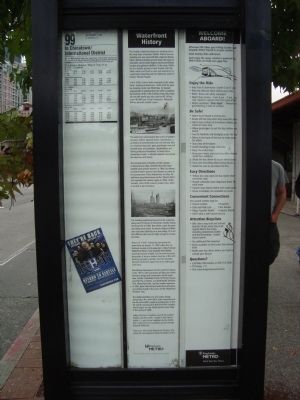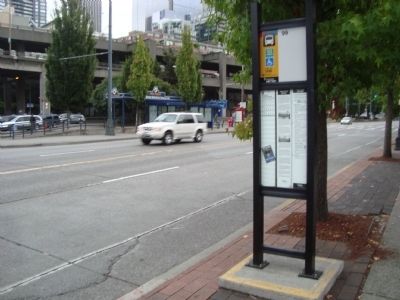Downtown Seattle in King County, Washington — The American West (Northwest)
Waterfront History
In the 1850’s Henry Yesler emerged as the waterfront’s leading businessman. Yesler built his piers by dumping rocks into Elliot Bay. He hauled wagonloads of sawdust from his mills to stabilize the footings of the wharf. Ballast from ships from all over the world was also used as fill. In fact, some 40,000 tons of San Francisco’s Telegraph Hill lies beneath Seattle’s piers.
The waterfront soon became the center of Seattle’s business district. General stores, warehouses, a gristmill and sawmill jutted out over the bay. Piers were built to load coal, grain and timber onto tall masted ships and steamers. Shipbuilding and fishing industries flourished. To move these tremendous loads, a railroad network crisscrossed the wharves and streets.
The pioneer men of Seattle, in their unique entrepreneurial style, decided that their town needed some pioneer women. In 1864, Asa Mercer recruited eleven women from Boston to come to the young town. They docked here on May 16, and have since been known as the “Mercer Girls.” Asa repeated the venture again in 1866. Unfortunately, most of the women jumped ship when it docked in San Francisco.
The bustling waterfront burned to the waterline along with 50 blocks of downtown Seattle during the Great Fire of 1889. But within a year, the piers and docks were rebuilt. An electric trolley to Ballard was built over Elliot Bay on a low bridge 20 to 60 feet offshore that was just high enough to escape the tides.
Shouts of “Gold!” echoed up and down the waterfront on August 17, 1887 when the S.S. Portland docked at Schwabacher’s Wharf (where Waterfront Park is now located) from Alaska carrying two tons of gold. For the next two years, thousands of fortune seekers lined up at the dock booking passage to Alaska. Visit the Klondike Museum in Pioneer Square for more of the gold rush story.
Recreational development of the waterfront began in the 1970’s with conversion of older pier sheds to house shops and restaurants. At the same time, Seattle rehabilitated much of Pioneer Square and Pike Place Market, and built Myrtle Edwards Park, Waterfront Park, and the Seattle Aquarium. In 1982, these historical and waterfront attractions were linked together by service on the Waterfront Streetcar Line.
The implementation of a new urban design advanced in the mid-1990’s with the construction of the Port of Seattle’s modern headquarters at Pier 69 and the opening of its Bell Street Pier complex, which began serving Alaska-bound cruise ships in the spring of 2000.
Today, the Port of Seattle is one of the world’s largest container ports. Seattle is the closest major U.S. port to our neighbors in the Pacific Rim. Cargo from 125 countries passes through the port each year.
Enjoy your ride on the Waterfront Streetcar Line along this very important stretch of Seattle’s history.
Erected by King County Metro.
Topics. This historical marker is listed in this topic list: Waterways & Vessels. A significant historical month for this entry is May 1908.
Location. 47° 36.45′ N, 122° 20.53′ W. Marker is in Seattle, Washington, in King County. It is in Downtown Seattle. Marker is on Alaskan Way, on the right when traveling south. Touch for map. Marker is at or near this postal address: 1401 Alakan Way, Seattle WA 98101, United States of America. Touch for directions.
Other nearby markers. At least 8 other markers are within walking distance of this marker. Joshua Greene (within shouting distance of this marker); The Visit of President Theodore Roosevelt’s “Great White Fleet” (within shouting distance of this marker); "Ton of Gold" (within shouting distance of this marker); ‘Miike Maru’ (about 400 feet away, measured in a direct line); "This Market Is Yours" (about 600 feet away); Welcome to The Public Market (about 600 feet away); First Avenue (about 700 feet away); a different marker also named Welcome to The Public Market (approx. 0.2 miles away). Touch for a list and map of all markers in Seattle.
More about this marker. The Waterfront History marker is duplicated at several other bus stops on Alaskan Way.
Credits. This page was last revised on February 7, 2023. It was originally submitted on October 9, 2011, by Barry Swackhamer of Brentwood, California. This page has been viewed 803 times since then and 23 times this year. Photos: 1, 2. submitted on October 9, 2011, by Barry Swackhamer of Brentwood, California. • Syd Whittle was the editor who published this page.

